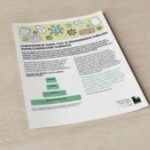Transmission of Covid-19 through paper/cardboard surfaces
By: Sam Upton for Two Sides
The world has changed very rapidly in recent months. Almost every aspect of daily life has changed completely, from business and politics to culture and society, and it will be a while before everything returns to normal.

Transmission of Covid-19 through paper surfaces
At a time when there is intense focus on the spread of Covid-19 and ways in which that spread can be reduced, much attention has been given to different surfaces and how those surfaces can retain and potentially spread the virus. Since paper and cardboard are very physical media, they have been under the spotlight, with concerns expressed about whether people can contract the coronavirus simply by touching them. So we have investigated the facts surrounding the transmission of Covid-19 through paper/cardboard surfaces.
The facts
Research and guidance from the world’s leading health organizations, including the World Health Organization (WHO), the Journal of Hospital Infection and the National Institute of Allergy and Infectious Diseases, suggest that the risk associated with surface transmission of Covid-19 is relatively low. According to the World Health Organization, the likelihood that an infected person will contaminate commercial products is low and the risk of contracting the virus that causes Covid-19 from a package that has been moved, traveled and exposed to different conditions and temperatures is also low. [1]
The most authoritative scientific research on the topic of surface infection rate is from the National Institutes of Health (NIH), the Centers for Disease Control (CDC), UCLA and Princeton University, which studied how stable the coronavirus was on different surfaces. It found that among plastic, stainless steel, and cardboard, the virus lasted the longest in plastic (up to 72 hours) and the shortest in cardboard (up to 24 hours) [2]. That time is shortened when the surface is exposed to air, and the virus becomes less powerful as it is exposed. The printing process will also decrease the potency of any virus.
Newspapers are quite sterile because of the way they are printed and the process they have gone through, said George Lomonossoff, a virologist at the John Innes Center in the United Kingdom. Traditionally, people have eaten fish and chips in them for that very reason. So, all the ink and printing makes them really quite sterile. The possibilities of [being infected] are infinitesimal. [3]
Addressing concerns
In addition to the conditions under which the paper is made, and the printing and distribution processes that significantly reduce the amount of viable particles needed to infect someone, the material itself is not a good location for the virus to exist. Researchers found that the coronavirus lasts longer on smooth, non-porous surfaces such as plastic. Because paper and cardboard are porous, they have the least power for the shortest time [2].
Further research on the relationship between Covid-19 transmission and surfaces will undoubtedly be conducted in the coming months and years. Understanding this pandemic is vital if we are to avoid a repeat of its devastating consequences. But it is also vital to address concerns about its spread, and we will work hard to keep you up to date on the latest paper and board research.
1] International News Media Association (inma), 2020
2] Aerosol and surface stability of HCoV-19 (SARS-CoV-2) compared with SARS-CoV-1, 2020
3] Interview with BBC Radio Scotland, March 2020 Translated with www.DeepL.com/Translator (free version)
(translation automatically by deepl.com)
Transmisión de Covid-19 a través de superficies de papel / cartón
Por: Sam Upton para Two Sides
El mundo ha cambiado muy rápidamente en los últimos meses. Casi todos los aspectos de la vida diaria han cambiado por completo, desde los negocios y la política hasta la cultura y la sociedad, y pasará un tiempo hasta que todo vuelva a la normalidad.
En un momento en que hay un enfoque intenso en la propagación de Covid-19 y las formas en que se puede reducir esa propagación, se ha prestado mucha atención en diferentes superficies y cómo esas superficies pueden retener y potencialmente propagar el virus. Dado que el papel y el cartón son medios muy físicos, han estado bajo el foco de atención, con preocupaciones expresadas sobre si las personas pueden contraer el coronavirus simplemente tocándolos. Así que hemos investigado los hechos relacionados con la transmisión de Covid-19 a través de superficies de papel / cartón.
Los hechos
La investigación y la orientación de las principales organizaciones de salud del mundo, incluidas la Organización Mundial de la Salud (OMS), el Journal of Hospital Infection y el Instituto Nacional de Alergias y Enfermedades Infecciosas, sugieren que el riesgo relacionado con la transmisión de Covid-19 desde las superficies es relativamente bajo. Según la Organización Mundial de la Salud, la probabilidad de que una persona infectada contamine productos comerciales es baja y el riesgo de contraer el virus que causa COVID-19 de un paquete que ha sido trasladado, viajado y expuesto a diferentes condiciones y temperaturas también es bajo
. [1]
La investigación científica más referenciada sobre el tema de la tasa de infección superficial es de los Institutos Nacionales de Salud (NIH), los Centros para el Control de Enfermedades (CDC), UCLA y la Universidad de Princeton, que estudiaron qué tan estable era el coronavirus en diferentes superficies. Encontró que entre el plástico, el acero inoxidable y el cartón, el virus duró más tiempo en plástico (hasta 72 horas) y el más corto en cartón (hasta 24 horas) [2]. Ese tiempo se acorta cuando la superficie está expuesta al aire, y el virus se vuelve cada vez menos potente a medida que se expone. El proceso de impresión también disminuirá la potencia de cualquier virus.
Los periódicos son bastante estériles debido a la forma en que se imprimen y el proceso por el que han pasado
, dijo George Lomonossoff, virólogo del Centro John Innes en el Reino Unido. Tradicionalmente, la gente ha comido pescado y papas fritas en ellos por esa misma razón. Entonces, toda la tinta y la impresión los hacen realmente bastante estériles. Las posibilidades de [ser infectado] son infinitesimales
. [3]
Abordar las preocupaciones
Además de las condiciones de fabricación del papel, además de los procesos de impresión y distribución que disminuyen significativamente la cantidad de partículas viables necesarias para infectar a alguien, el material en sí no es una buena ubicación para que exista el virus. Los investigadores descubrieron que el coronavirus dura más en superficies lisas y no porosas como el plástico. Como el papel y el cartón son porosos, tienen la menor potencia durante el menor tiempo [2].
Sin duda habrá más investigación sobre la relación entre la transmisión de Covid-19 y las superficies en los meses y años venideros. Comprender esta pandemia es vital si queremos evitar una repetición de sus devastadoras consecuencias. Pero también es vital abordar las preocupaciones relacionadas con su propagación, y trabajaremos arduamente para mantenerlo actualizado sobre las últimas investigaciones en papel y cartón.
